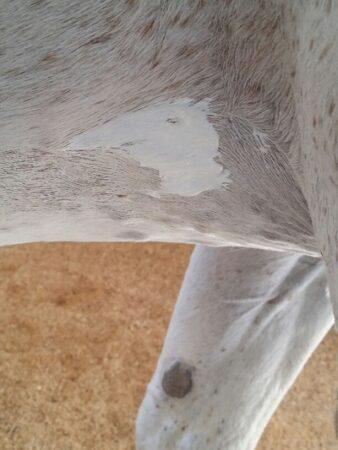Understanding Insect Bite Hypersensitivity in Horses
Insect Bite Hypersensitivity (IBH) is a type of allergic skin disease in horses. It occurs when a horse’s immune system overreacts to insect bites, primarily from Culicoides spp. insects. These bites can cause persistent itching and skin inflammation, paving the way for secondary infections. IBH is also called Queensland itch, sweet itch, or summer eczema. Here’s what you need to know about insect bite hypersensitivity in horses.
Table of Contents
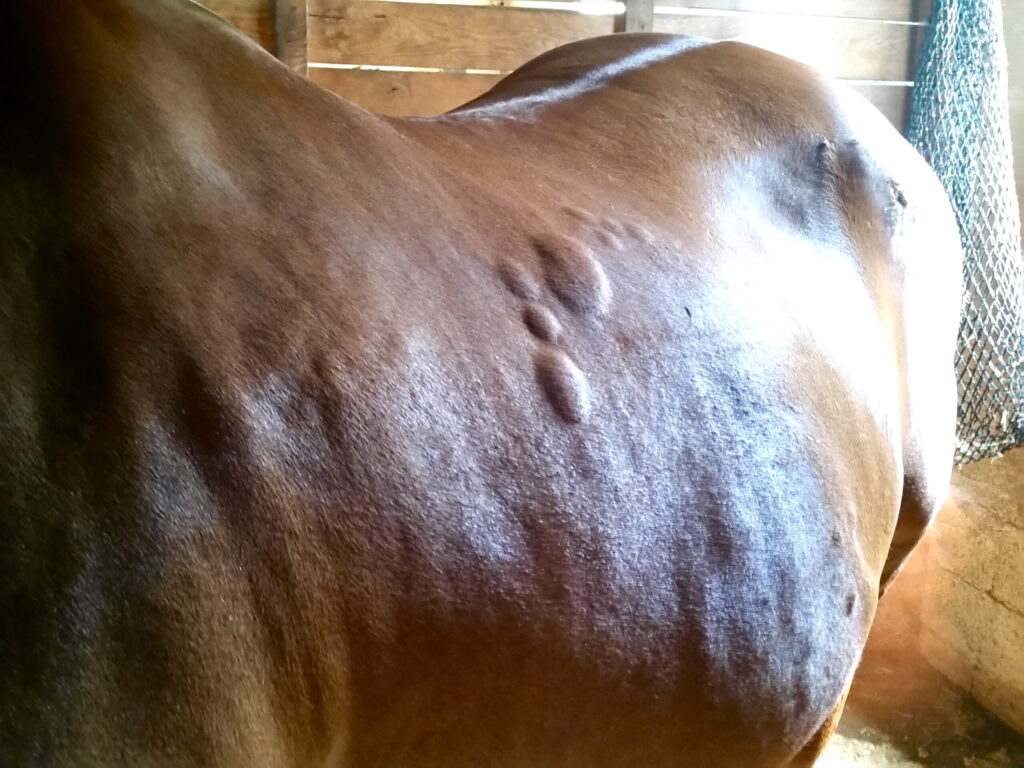
Overview of Insect Bite Hypersensitivity (IBH)
- The primary source of IBH in horses is the Culicoides fly, a tiny ectoparasite also known as midges, no-see-ums, or gnats. These minuscule insects bite your horse, triggering a profound allergic reaction with severe itching. Horses will then scratch and rub themselves raw to alleviate this itch. It’s a cyclical process, with more bites creating more itch and the greater potential for more self-mutilation.
Definition and Significance of IBH
- A horse’s immune system overreacts to the saliva of these biting flies. During a bite, saliva transfers from the midge to the horse’s skin, and the major basic proteins in the saliva are an allergen. Allergic reactions are common with insect bites, characterized by localized swelling and itching. You may even see hives, technically called urticaria.
- However, with IBH in horses, the immune reaction is excessive, resulting in large areas of swelling and itching. Secondary bacterial infections occur when scratching creates sores and wounds that become infected. Reactions can worsen over time as well.
Prevalence and Affected Breeds
- Horses all over the world develop insect bite hypersensitivity, and it’s seen quite often in Icelandic horses and parts of Australia, particularly in the Queensland area, hence the name Queensland itch.
- There are many factors linked to IBH, genetics being one of them. Icelandic horses, Friesians, Arabian horses, and Shetlands may be more likely to develop insect bite hypersensitivity.
- The climate, seasons, and insect populations of an area also influence the prevalence of sweet itch.
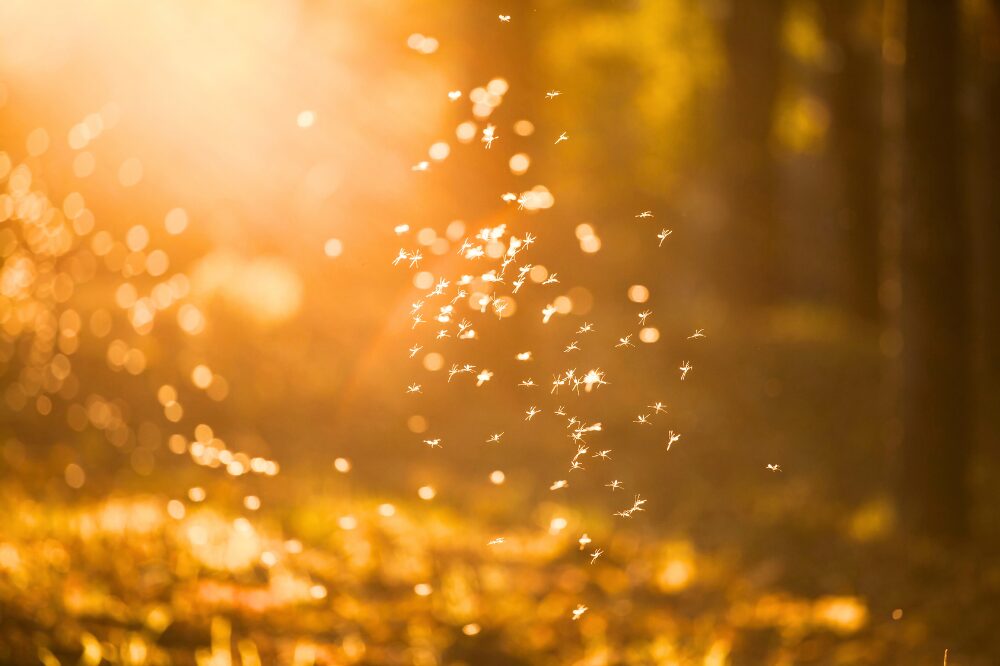
Sometimes you only know midges are around is when you swallow one of catch them in the sunlight.
Common Allergen Culprits in Equine IBH
- Biting midges of the Culicoides variety are the usual suspect with insect bite hypersensitivity, but other flying creatures can trigger IBH. This list includes mosquitoes, black flies, stable flies, horseflies, and other biting bugs.
Signs of Insect-Related Dermatitis and IBH
- For some types of flies, a horse’s reaction may be a singular hive or patch of hives around the bite. You may notice that your horse has minor itching in that area.
- Other clinical signs of IBH include:
-
- Itching
- Hair loss
- Hives
- Oozing, crusty skin
- Open sores
- Scabs
- Peeling skin
- Bacterial infections
Typical Locations and Appearance of Lesions
- Most often, sweet itch caused by midges creates sores and reactions along the dorsal portion of the horse. Their tail, back, withers, and mane are usually most affected, as that’s where midges land most often. For other flies that cause insect bite hypersensitivity in horses, the reaction can occur anywhere, as they hunt, land, and bite in different locations depending on the type of fly.
- In the case of hives, the reaction can sometimes drip down, and the fluid in the hives succumbs to gravity.

This mane is rubbed out due to sweet itch.
Pathophysiology of Insect Bite Hypersensitivity
- There is a complex set of immune reactions that causes the pathogenesis of insect bite hypersensitivity in horses. When a horse comes in contact with allergens like the salivary gland proteins from culicoides spp, the horse’s body has a strong immune response. This response mobilizes immunoglobulin E (IgE) antibodies for protection to fight the allergen.
- Upon first exposure, the IgE attaches to the mast cells in the horse’s skin, serving as a warning to other immune cells about the allergen.
- When the saliva reappears, as it does with bugs, the IgE signals the release of histamines and cytokines.
- When substances like pollen, dust, or insect saliva (such as that from midges) enter the body, most people are fine, but individuals with allergies treat it as a serious threat. The first time you’re exposed, your immune system makes a special antibody called IgE (Immunoglobulin E).
- Next time the allergen appears, the IgE signals special cells to release histamines and cytokines.
Histamines and cytokines
- Histamines are a biogenic amine, a small organic compound based on nitrogen. Two types of cells produce histamines: mast cells and basophils, which are types of immune cells. Histamines increase blood flow to an area, but also cause the vessels to get leaky. The area will swell, turn red, and itch.
- This is how antihistamines combat allergic reactions by targeting the underlying cause of itching, redness, and swelling.
- Cytokines are signaling molecules that are also integral to the immune system. Immune cells, such as T cells, mast cells, and macrophages, release them. These specialized compounds direct traffic to other cells, instructing them to release more antibodies while also promoting inflammation.
- The entire process is designed to protect your horse from bug saliva, but sometimes things get out of hand, and the immune system becomes Oscar-worthy in its dramatic response.
This scientific article includes photos that illustrate varying degrees of IBH in horses.
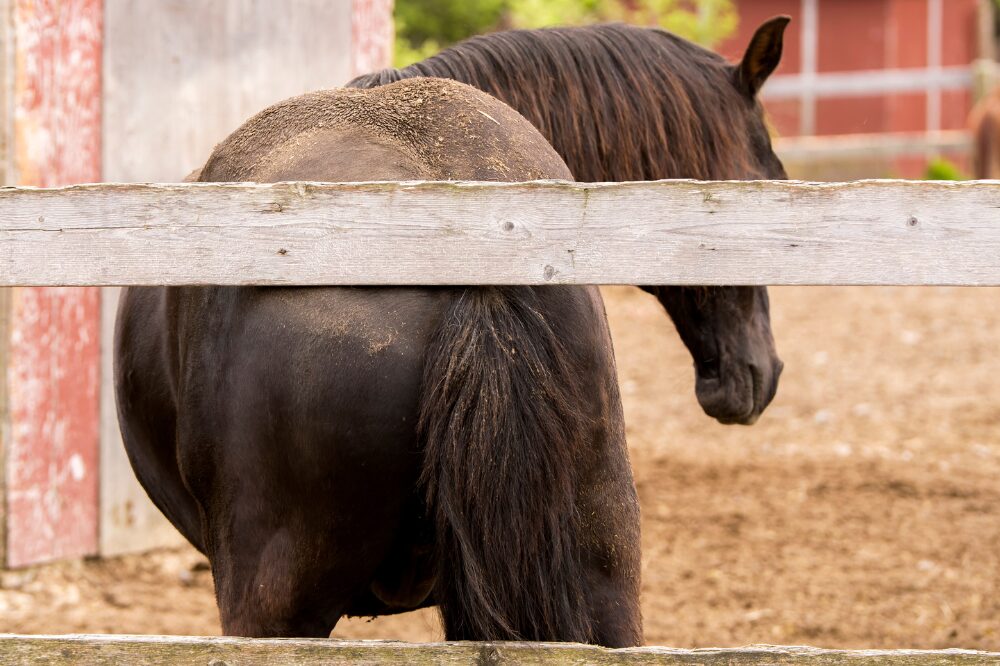
Diagnosis of IBH in Horses
- Your vet looks for signs of an allergic reaction, which, with IBH, can be obvious. If your vet arrives early in the allergy-reaction cycle, they will likely see hives, swelling, and evidence of itching, like patchy manes and tails. As the itching persists, horses may scratch themselves into open wounds.
- Your veterinarian may also want to perform blood work or specialized skin testing to confirm a diagnosis of insect bite hypersensitivity. Considering the types of flies on the farm can also help narrow down possible culprits.
Intradermal skin testing and serum allergy testing
- Intradermal skin testing is one method for detecting insect bite hypersensitivity. In this test, small amounts of things like salivary gland proteins from culicoides spp. are put right under the horse’s skin. If there is swelling or inflammation in that spot, it shows the horse is sensitive to that allergen. Another test, called serum allergy testing, can also be helpful. This test checks the IgE levels in the horse’s blood for many allergens.
- If your horse were to visit an allergist, as humans do, they may receive a series of desensitizing injections to help alleviate the reactions. However, with so many species of insects to blame, this is not a practical solution. However, advancements in serum allergen testing may change that, and hopefully soon.
Scoring and assessing the severity of IBH
- Vets use a scoring system to describe the intensity of an IBH reaction. A scale of 1 to 10 is used, with one being mild and 10 being severe. The scoring can become more complicated if factors such as location and severity of lesions are taken into account.
Management and Prevention Strategies
- You have many tools to help your horse stay comfortable when battling insect bite hypersensitivity. It boils down to knowing what flies abound, and tackling those first.
Fly control at the barn
- You need to become a master of fly control at the barn, and you should attack the fly populations from all angles and life stages of the flies. Here are some fly control tips:
- Pick stalls, paddocks, and fields often. Dispose of manure, urine, and shavings away from the barn.
- Use fly predators. These wasps eat the larvae of common flies around barns and farms.
- Deploy fly traps far away from the barn. Let the stinky bait lure the flies in the opposite direction of your horse.
- Use fly sheets, fly masks, and fly boots. There are full body fly sheets made specifically for horses with insect bite hypersensitivity.
- Keep your horse inside during peak activity times for bugs, especially dawn and dusk. If you can, screen in their area.
- Fly sprays are great when they work on the flies that your barn has. You have numerous choices in spray ingredients, including fatty acids, essential oils, and insecticides.
- Feed-through fly control can be effective if every horse in the vicinity uses it, and it begins 6 weeks before the flies emerge.
- Keep everything windy. Fans and natural ventilation help.
Read more about fly control here.
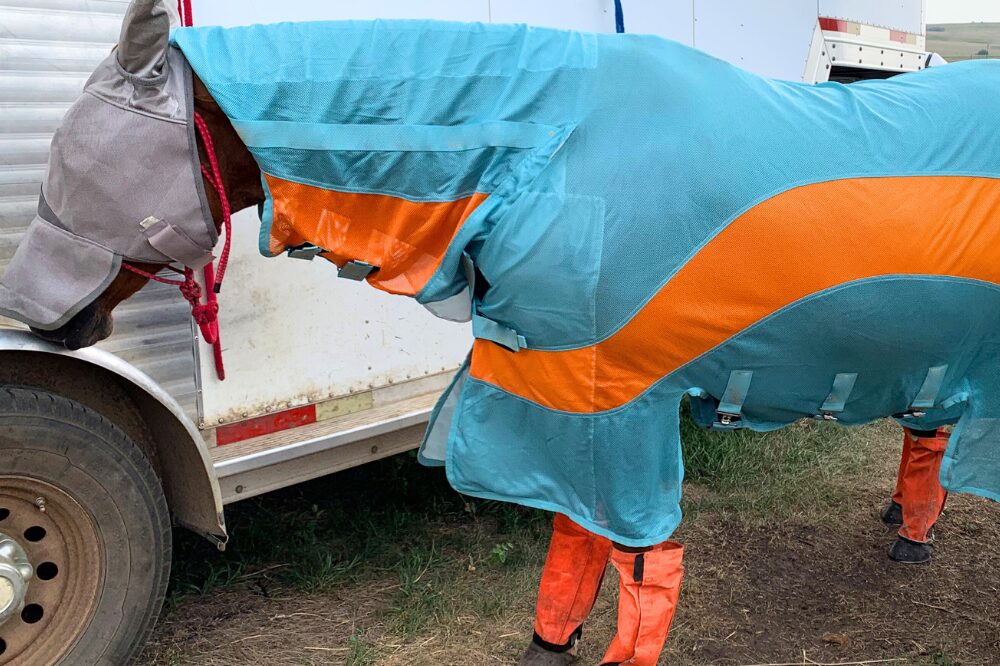
Is there such a thing as too much fly protection? For some horses, not really!
Treatment Options for Insect Bite Hypersensitivity in Horses
- Your veterinarian can provide oral and topical treatments for insect bite hypersensitivity in horses. Not all treatments are suitable for all horses, and a period of trial and error may be necessary to determine what works best.
Traditional Therapies and Medications
- Corticosteroids are often the first choice. They help reduce inflammation and alleviate the itching associated with dermatitis. Antihistamines can also make things better, and there are many varieties your vet can suggest for you.
- If there are sores or hair loss that can easily become infected, topical treatments can help alleviate the condition. Prescription shampoos can soothe the skin, and ointments with steroids or antibiotics may alleviate some of the itching. Sometimes a cream as simple as diaper rash medicine may help.
- In severe cases with open sores, antibiotics may be necessary to treat any secondary infections caused by those tiny Culicoides midges.
Immunotherapy and Emerging Treatments
- Some new therapies involving treating the immune system show promise. These treatments work by making the immune response less strong to certain Culicoides spp allergens.
- There are also new treatments that utilize biologics, which target the body’s pathways that cause hypersensitivity. These new methods may provide targeted relief for individuals with allergies. They can help avoid the adverse effects that may occur with corticosteroids and may be a long-term solution for equine insect bite hypersensitivity.
- Many immunotherapy treatments act like vaccinations, and hopefully, one day, the technology can help many horses avoid the bite-to-itching-to-sores cycle.
As an advocate for your horse’s health, learning about the types of flies in your area and how your horse reacts to these flies goes a long way in helping your horse avoid and overcome IBH.
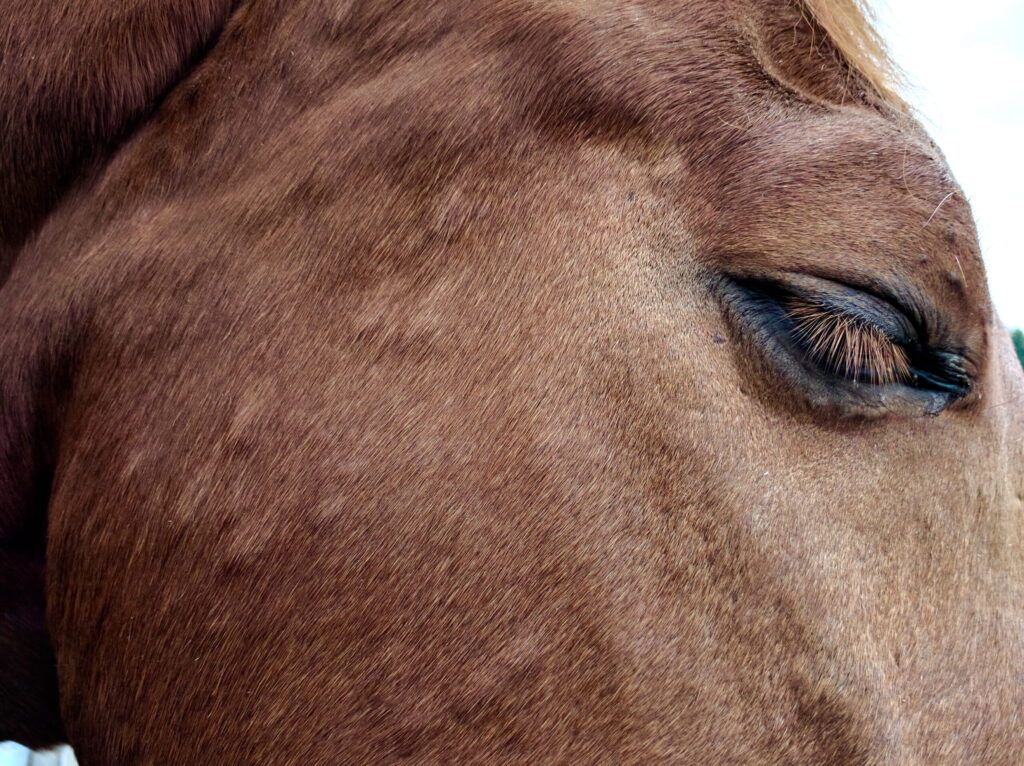
Hives can be anywhere, of any size!
Frequently Asked Questions
What time of year is IBH most severe in the U.S.?
In the U.S., the prevalence of IBH in horses typically worsens during the warm months. This often happens from late spring to early fall. During this time, Culicoides spp. and other biting insects become more active, resulting in increased reactions.
Can IBH be cured completely in horses?
Insect bite hypersensitivity (IBH) in horses has no cure, but can be managed. The primary goal of treatment is to alleviate symptoms and prevent horses from being exposed to insects that cause problems. Some horses will improve significantly with the proper steps and good, steady management of fly populations.
How can horse owners differentiate IBH from other skin conditions?
Itching and excessive scratching, paired with hair loss and lesions, are common indicators for IBH, but can also signal other skin infections. Work with your vet for a definitive diagnosis and then treat accordingly.
Are particular horse breeds more susceptible to IBH?
Some horse breeds may be more prone to insect bite hypersensitivity (IBH). Breeds such as the Arabian, Icelandic, Friesian, and Thoroughbred are more likely to exhibit this behavior due to their genetic factors, although any equine breed can be susceptible.
What are the risks if IBH is left untreated?
If insect bite hypersensitivity (IBH), also known as equine summer eczema, is not treated, it can lead to open sores and secondary skin infections. This impacts a horse’s overall health and comfort; damaged skin is not suitable for horseback riding.
Key Highlights
- Insect Bite Hypersensitivity (IBH), also called Queensland itch and sweet itch, is the most common allergic skin disease in horses caused by biting insects like Culicoides spp.
- Genetic predisposition and immune response play significant roles in the development of equine insect bite hypersensitivity.
- Typical clinical signs of IBH include itching, lesions, hair loss, and skin thickening.
- Management revolves around prevention techniques, environmental control, and treatment of IBH using corticosteroids and fatty acids.
- Affected breeds, such as Icelandic horses, may exhibit heightened reactions due to genetic factors and environmental changes.
SOURCES
https://pdfs.semanticscholar.org/309a/eb039dd77c997d1e312da7e1446aab713025.pdf Citation: Cvitas I, Oberhaensli S, Leeb T, Marti E (2022) Equine keratinocytes in the pathogenesis of insect bite hypersensitivity: Just another brick in the wall? PLoS ONE 17(8): e0266263. https://doi. org/10.1371/journal.pone.0266263
Cox, A., & Stewart, A. J. (2023). Insect Bite Hypersensitivity in Horses: Causes, Diagnosis, Scoring and New Therapies. Animals : an open access journal from MDPI, 13(15), 2514. https://doi.org/10.3390/ani13152514
Table of Contents
Go Shopping
Stock up here for your horse supplies! As an Amazon Associate, I earn from qualifying purchases, but it’s ZERO extra cents to you. As a Walmart Associate, I earn from qualifying purchases as part of their affiliate plan. I appreciate your support! You can also visit my Amazon storefront here: PEG storefront.
Sweet itch is best battled by not letting those annoying midges bite your horse.
This hoof is perfect for protecting the mane and neck from insects.
No bug shall make its way onto your horse with this battle-ready sweet itch sheet.
For horses with particularly sensitive faces and ears.
Some sheath protection for horses very sensitive to the bugs.
Fair warning - this spray has an odd aroma - but it works for some types of flies!


